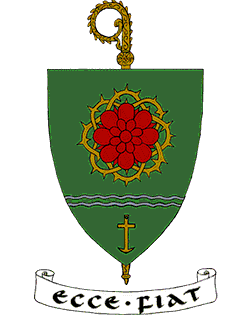Dear Friend of Clear Creek Abbey,
In the following meditation one of our agricultural monks endeavors to have us see, in all its noble splendor and usefulness—amid the forest that surrounds it— the theological beauty of the tree. — br. Philip Anderson, abbot
“A tree hath hope….” The words of Job (14:7) come to mind as we reflect on our little tree nursery here at Clear Creek Monastery, as the days lengthen through February and plans for spring planting begin to take shape. There are a variety of trees present, each for a different purpose, all lined up in their three-gallon pots, awaiting the shovel which will prepare their new and final home in the earth. There are pear trees, both grafted and ungrafted, pine trees of a native variety, and chestnut seedlings grown from seed sources both near and far. There is also a cluster of potted oaks, knee-high as yet, chosen for their acorn-bearing capabilities, needing only time to show what they can do. One day they will be sixty feet tall or more, God willing, and will rain down acorns for monk and beast alike. Most of them are of the variety called “bur oak;” the Latin name is Quercus Macrocarpa—literally, “Bigfruit Oak,” which speaks to their potential. Acorns are high in oils and carbohydrates, and the bur oak, after  growing for up to a century and a half as one of the longer-lived varieties, makes good lumber too. The woodshop (assuming that there still are woodshops then), will be putting this wood to good use around the Year of Our Lord 2170.
growing for up to a century and a half as one of the longer-lived varieties, makes good lumber too. The woodshop (assuming that there still are woodshops then), will be putting this wood to good use around the Year of Our Lord 2170.
Which brings us back to hope. When we plant a tree here, we try to think long term. This is not an act of “ecological virtue” (as if there were such a thing); it is rather an act of theological virtue, namely—hope. The theological virtues—faith and hope and charity—are in somewhat short supply today, and of the three, hope is often the one most easily overlooked (while despair seems perversely fashionable). When we plant a tree, it is an act of trust; there will be no instant return on the investment. It is as if we are saying to God: “Lord, we trust that You will provide all things needful for the life of this tree—the sun, the rain, and more importantly—the monastic vocations to tend and harvest the trees for years to come, that one day this tree may be a source of the Corporal Works of Mercy. Though it may take decades to fulfill all this, Your fidelity will remain; and we trust that You will raise up new generations of monks to bring all this to fruition.” It is analogous to trustingly designing buildings to last for a thousand years, a plan which is, of course, ultimately in the hands of Providence. A Chinese proverb has it: “If you are planting for one year, plant grain. If you are planting for ten years, plant trees. If you are planting for a hundred years, plant men.” The monks of Clear Creek are attempting to do all of this in one holistic package: tending our vegetable garden with its annual harvests, planting trees with their perennial harvests, forming the young men who come to us, and yes, designing buildings to last.
Speaking of grain, there is another project we are working on. The garden and the metal shop are teaming up to redesign a no-till drill for the purpose of planting cover crops and grass seed—and grain as well. After a fair amount of research, we obtained an ancient planter (faded green with yellow trim) at an auction, flat tires and all. As it was too wide for our gates here and too large for our tractor to pull, we are cutting it apart, reworking the design, and adding the parts we need so as to make it perform in our particular conditions. It is made to plant seed in such a way as to not disturb the soil, or to do so very minimally. This is important for maintaining the soil biology—all the organisms from the microscopic up to earthworms and dung beetles—which all happily work together for the good of the soil and thus for the production of grass—and for all which depend on the grass: chickens, sheep, and beef and dairy cattle. By minimally disturbing the soil, we also help prevent soil erosion. It is interesting here to note God’s opinion on soil erosion—and yes, He does have one and gives it very clearly in Sacred Scripture. In the very first Psalm (and remember, the Psalms are the bread-and-butter of the Church’s liturgy, and thus of monks), the virtuous man is said to be “like a tree which is planted near the running waters, which shall bring forth its fruit in due season” (Ps. 1:3; cf. also Jeremiah 17:8). And indeed, we aim at such an agricultural system by setting up a network of water catchments, alongside which we plant all sorts of trees, in design known as permaculture. But by way of contrast to such landscape hydration, the same Psalm goes on to say: “Not so the wicked, not so: but like the dust, which the wind driveth from the face of the earth” (v. 4). The whole Psalter is chock-full of comparisons, metaphors and imagery, but it is interesting to note the very first comparisons used in the book: the good are said to be like watered trees, while the wicked are likened to the scattering effects of soil erosion before the face of the wind. God must have a divine dislike of soil erosion in order for Him to use such a comparison, and monks have taken note of this: in the tools we choose, in the tools we build, and in the tools we choose to build. By minimizing tillage, we protect our soil which then is productive of grass and life and the concrete means of charity, a charity which goes through the kitchen by means of the Corporal Works of Mercy—more specifically, the feeding of the hungry Christ, Who hides Himself in guests and brethren.
Another proverb, this time from Zaire, says: “One tree makes much noise as it falls, but no one hears the growing of the forest.” The media, Catholic or otherwise, noisily trumpets whenever a tree falls in the Church. The monks of Clear Creek would invite you to shut off the media and come join us in thanking Christ our Hope for the growing of the forest.
– A Monk of Clear Creek




